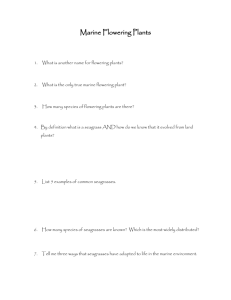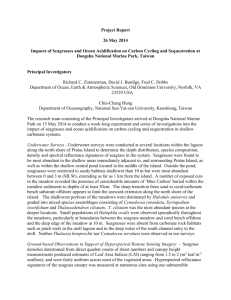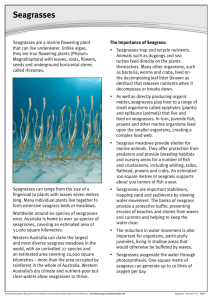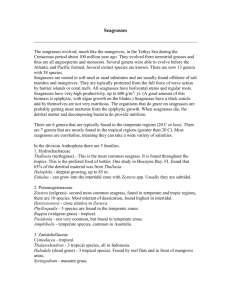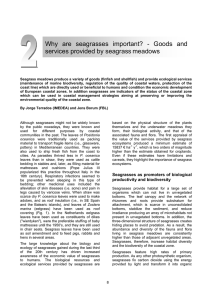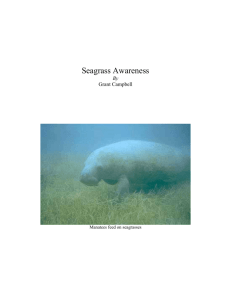Seagrass and Mangrove
advertisement
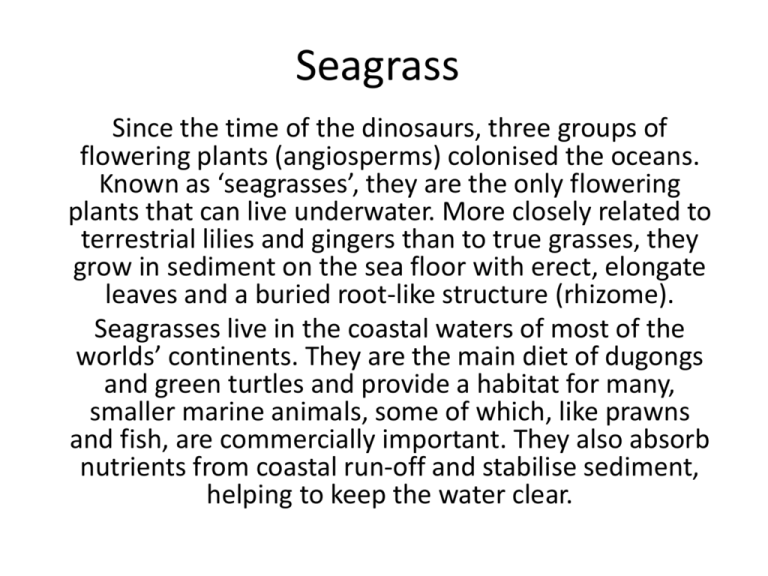
Seagrass Since the time of the dinosaurs, three groups of flowering plants (angiosperms) colonised the oceans. Known as ‘seagrasses’, they are the only flowering plants that can live underwater. More closely related to terrestrial lilies and gingers than to true grasses, they grow in sediment on the sea floor with erect, elongate leaves and a buried root-like structure (rhizome). Seagrasses live in the coastal waters of most of the worlds’ continents. They are the main diet of dugongs and green turtles and provide a habitat for many, smaller marine animals, some of which, like prawns and fish, are commercially important. They also absorb nutrients from coastal run-off and stabilise sediment, helping to keep the water clear. • Seagrasses are unique amongst flowering plants, in that all but one genus can live entirely immersed in seawater. Enhalus plants are the exception, as they must emerge to the surface to reproduce; all others can flower and be pollinated under water. Adaptation to a marine environment imposes major constraints on morphology and structure. The restriction of seagrasses to seawater has obviously influenced their geographic distribution and speciation. • Seagrass can reproduce through sexual or asexual methods. In sexual reproduction, the plants produce flowers and transfer pollen from the male flower to the ovary of the female flower. Most seagrass species produce flowers of a single sex on each individual, so there are separate male and female plants. Composite illustration demonstrating morphological features used to distinguish main seagrass taxonomic groups. By Len McKenzie (2008). Types of sea grass http://www.seagrasswatch.org/id_seagrass.html Where does seagrass grow? • A number of environmental parameters are critical to whether seagrass will grow and persist. These include physical parameters that regulate the physiological activity of seagrasses (temperature, salinity, waves, currents, depth, substrate and day length), natural phenomena that limit the photosynthetic activity of the plants (light, nutrients, epiphytes and diseases), and anthropogenic inputs that inhibit access to available light for growth (nutrient and sediment loading). Various combinations of these parameters will permit, encourage or eliminate seagrass from a specific location. • Seagrasses occupy a variety of coastal habitats. Seagrass meadows typically occur in most shallow, sheltered soft-bottomed marine coastlines and estuaries. These meadows may be monospecific or may consist of multispecies communities, sometimes with up to 12 species present within one location. • The depth range of seagrass is usually controlled at its deepest edge by the availability of light for photosynthesis. Exposure at low tide, wave action and associated turbidity and low salinity from fresh water inflow determine seagrass species survival at the shallow edge. Seagrasses survive in the intertidal zone especially in sites sheltered from wave action or where there is entrapment of water at low tide, (e.g., reef platforms and tide pools), protecting the seagrasses from exposure (to heat, drying) at low tide. Why conserve seagrass? • The habitat complexity within seagrass meadows enhances the diversity and abundance of animals. Seagrasses on reef flats and near estuaries are also nutrient sinks, buffering or filtering nutrient and chemical inputs to the marine environment. They also stabilise coastal sediments. • They also provide food and shelter for many organisms, and are a nursery ground for commercially important prawn and fish species. The high primary production rates of seagrasses are closely linked to the high production rates of associated fisheries. These plants support numerous herbivore- and detritivore-based food chains, and are considered very productive pastures of the sea. The associated economic values of seagrass meadows are very large, although not always easy to quantify. • Seagrass/algae beds are rated the 3rd most valuable ecosystem globally (on a per hectare basis), only preceded by estuaries and wetlands. The average global value of seagrasses for their nutrient cycling services and the raw product they provide has been estimated at 1994US$ 19,004 ha1 yr-1 (Costanza et al. 1997). This value would be significantly greater if the habitat/refugia and food production services of seagrasses were included. Algae (seaweed): often confused with seagrass • Algae are plants that also colonised the sea and are often confused with seagrasses, however, they are more primitive than seagrasses. In contrast to seagrasses, algae do not have a true root system (they have holdfasts) and do not have veins that carry molecules around the plant. • Algae have spores and do not flower or produce fruit, while seagrasses have seeds and fruit. Seagrass vs Algae Seagrass Marine Algae Complex root structure to anchor Simple holdfast to anchor to hard plant in the sediment, and extract substrate such as rocks or shells nutrients and minerals Photosynthesis restricted to cells in Photosynthesis undertaken by all leaves cells Transport minerals and nutrients in Uptake of minerals and nutrients aerenchyma and the lacunae (veins) from water column via diffusion Reproduction via flowers, fruits and Reproduction via spores seeds http://www.seagrasswatch.org/publica tions.html • What two related ecosystems are important to coral reef ecology? Mangroves – tropical inshore forests dominated by trees and shrubs that grow in salt water – Trap and break down organic matter – Filter pollutants and sediments – Habitat for juveniles and invertebrates • Related ecosystems. . . Seagrass Beds – Facilitate sediment settlement – Recycle nutrients Seagrass-Coral-Mangrove interactions • Tropical seagrasses are important in their interactions with mangroves and coral reefs. All these systems exert a stabilizing effect on the environment, resulting in important physical and biological support for the other communities (Amesbury and Francis 1988). • Barrier reefs protect coastlines, and the lagoon formed between the reef and the mainland is protected from waves, allowing mangrove and seagrass communities to develop. Seagrasses trap sediment and slow water movement, causing suspended sediment to fall out. This trapping of sediment benefits coral by reducing sediment loads in the water. • Mangroves trap sediment from the land, reducing the chance of seagrasses and corals being smothered. Sediment banks accumulated by seagrasses may eventually form substrate that can be colonized by mangroves. All three communities trap and hold nutrients from being dispersed and lost into the surrounding oceanic waters. In the tropics, mangrove destruction is a serious concern. Mangrove is a general term used to describe a variety of tropical inshore ecosystems dominated by several species of trees or shrubs that grow in salt water. At one time, 60-75 percent of the earth’s tropical coastline and semi-tropical regions were lined with mangrove forests, but not any longer. It’s estimated that mangroves now occupy less than 50 percent of their original range and are disappearing faster than tropical rainforests. In many parts of Southeast Asia and South America, for example, large areas of mangroves were chopped down to build aquaculture ponds, or for use as firewood or charcoal.
